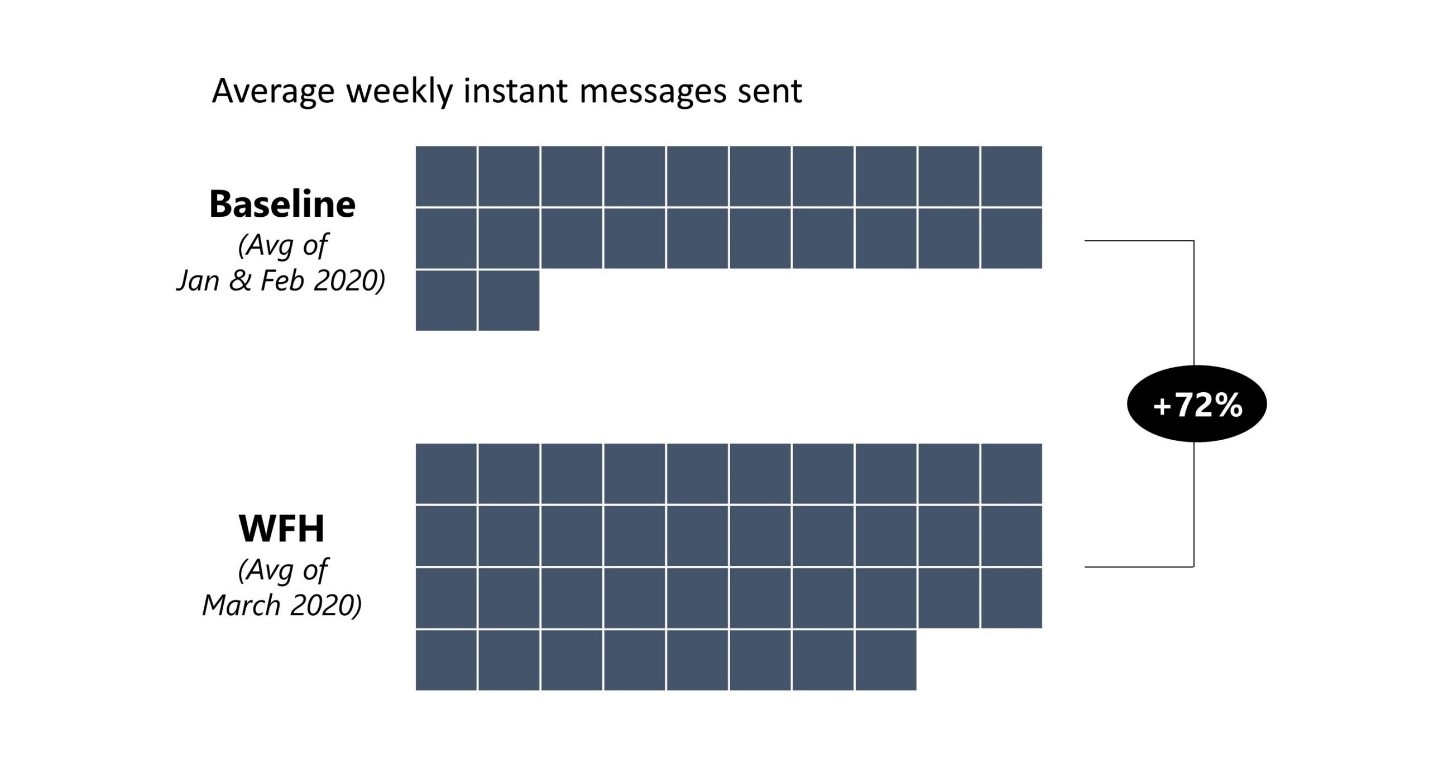As COVID-19 has compelled millions of us to stay home, we’re learning so much about connecting and collaborating remotely. Last week, I shared a post about how working from home impacted Microsoft China’s habits. In the follow-up below, the Modern Workplace Transformation team—based right here in Washington—examines how remote work has changed their own collaboration habits. Read on for their fascinating findings.

The rise of 30-minute meetings and other ways collaboration is changing
Heather Layne, Giancarlo Cozzi
Editor’s Note: COVID-19 has impacted people around the world, challenging us to adapt to travel restrictions, school closures, and the removal of barriers between work and life—all at once. So, what does a cross-functional team of engineers, data scientists, analysts, and marketers that live in the space between workplace culture and data do when presented with the world’s largest work-from-home shift? It, well, does its homework. In this blog series, we’ll share real-time learnings as we measure the impact of this unprecedented shift on how one group of employees works, connects and balances our lives. We hope these insights will teach us something about how work is changing and help us all get through this, together.
Humans are social beings, and the workplace is no different than other parts of our lives: to succeed, we need to connect and collaborate with others. From this lens, we were curious to see how our own Modern Workplace Transformation team would adapt to working 100 percent from home. Would people seek new ways of collaborating to fill the void left by our now dormant open-plan offices? Or would connectedness decline as people were forced to balance work with new demands at home? How would our social behaviors change? And what might we learn to help us, our customers, and our partners as ways of working continue to shift in the future?
To find answers, we looked at data that measures our everyday work in the tools we use to connect and collaborate, and we checked in with colleagues about what they’re experiencing via a sentiment survey. At least for our 300-person organization, one overarching conclusion is clear: The new conditions of working remotely generated new solutions and approaches. Data showed that our teams found new ways to socialize, dramatically changing the way and cadence in which we communicate with each other. And anecdotes supported the sense that, in some ways, we feel even closer to each other than before. As the saying goes, constraints breed creativity.
Meetings morph
When people closed their work offices and opened up their home offices, our weekly meeting time suddenly jumped 10 percent. This translates to an average of three additional meetings per week per employee. Roughly 7 out of 10 employees experienced at least some increase in meetings, and the increase didn’t discriminate by function—we saw it across our engineering, product, and business teams.
This didn’t necessarily surprise us: As we lost the ability to connect in unscripted ways inside our office—a casual hallway conversation, a catch-up over lunch—it made sense that we’d need to add in some virtual meeting time as a substitute. It’s also one of the most commonly cited impacts when we recently polled our team to ask how their work had changed. As one survey respondent put it, there’s no longer an opportunity “to just pop by to someone else’s office to ask a question.”
“I can’t wander over to someone’s desk or connect over coffee in the kitchen. As a result, I think I spend a lot more time in meetings.”
Finding: Shorter meetings increased while longer meetings decreased.
But a deeper dive shows the nature of our meetings changed, too. The first thing we noticed was short meetings taking the place of long meetings, with 22 percent more of the former (30 minutes or less) and 11 percent fewer of the latter (greater than 1 hour).

We knew that this embrace of shorter meetings didn’t stem from any official mandate or guidance. This response was organic, something our workforce did instinctually to optimize collaboration within shifting circumstances. What we really wanted to understand was why the turn to the 30-minute meeting?
Stories from our team give us two clues. On the one hand, we heard from many teams hungry for quick ways to stay connected—was the surge in new short meetings a sign that teams were replacing the ad hoc team lunch with a scheduled one, for instance? Many colleagues also mentioned the overall feeling of more meetings and tightly scheduled days—as one respondent noted, “people’s calendars seem to be more packed.” Maybe, we theorized, people were responding to the added demands by being more conservative and efficiency-oriented when scheduling other people’s time.
“I’m trying to be very efficient, meaningful, and considerate.”
Our curiosity was piqued—which was it? While it’s hard for data to reveal where meetings might have been shortened for efficiency reasons, we wanted to test the other theory. Were teams using short meetings to stay socially engaged and feel connected the way they used to do in person?
We asked our colleagues directly about what they’ve been experiencing, and two stories emerged: people were noticing more scheduled 1:1s and a proliferation of new social team events such as virtual lunches and happy hours, many enabled by video.
“I’m spending much more time now doing ‘check in’ conversations and social team meetings,” one survey respondent said.
“You have to make more of an effort to schedule social stuff like team lunch or team happy hours.”
Finding: Quick check-ins, 1:1s, and scheduled social meetings increased.
The data confirms these trends: We found 1:1s increased by 18 percent and check-ins and team social meetings grew by 10 percent. What captured our attention, even more, was that half of these new meetings were recurring.
These stories and data support existing research that regular touchpoints and rituals in times of instability or big change can help teams “foster a sense of connection, safety, and fun.” And we take them as a sign that our team is committing to persistent change. It might be easy to increase touchpoints during the first couple of weeks of remote work, but life and inertia could slowly lead to disconnection. By scheduling these recurring meetings our colleagues have taken a big step toward creating new norms to guide us long-term.
“We’re having more one-on-one scheduled meetings to replace those hallway conversations.”
For our organization, the embracing of shorter meetings is a fundamental shift. In an era when meetings have generally been multiplying and growing longer—the effects of which have been shown to negatively impact productivity and employee happiness—it’s interesting that our team naturally and quickly developed a new, just-right norm to use short meetings as a way to adapt.
The role of instant messaging
Scheduled meeting time is just one side of the collaboration coin. A team lunch via video conference or a new recurring meeting doesn’t fully replace the spontaneous water cooler or coffee machine conversation. Anyone who’s participated in a video conference with a large group knows they’re just not quite the same (remote birthday party, anyone?). So, we looked to see if we could determine where else that gap was being filled and found it in instant messaging.
Finding: The number of IMs sent surged.
Our data showed a dramatic 72 percent increase in instant messages sent during the work-from-home period, with the largest increase spanning from 10 AM to 5 PM. This surge was particularly noticeable among managers, who sent 115 percent more instant messages during March 2020, while individual contributors saw their instant messages jump more than 50 percent. The data made it clear that, absent the ability to connect in person, managers felt IMs were key to effectively managing their teams from home.

By coupling our anecdotal sentiment with Workplace Analytics data, we concluded that our team found ways to creatively adapt to the major shift in how we work. It’s clear that, using our team’s collective ingenuity and management’s leadership by example, we’ve been empowered to embrace the unpredictable. We don’t know yet where this journey will lead us, but we understand that to navigate it we need to continue nurturing community across our organization.
Read the rest of the series
- Part 1: When office work goes remote, what will we learn?
- Part 2: In China, managing relationships, teams, and more meetings from home
Methodology: To help us chronicle the journey of our 300-person organization, we draw on data from Workplace Analytics to help quantify the impact on collaboration, explore the lived experiences of our teammates through interviews, and tap into the knowledge of experts where it helps our understanding.

